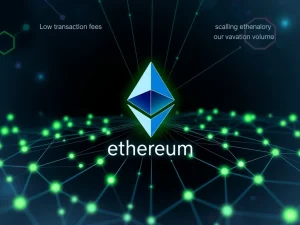Ethereum Layer 2s: Resilient Outperformance After $19B Crypto Market Crash

The cryptocurrency market recently experienced a significant Market Crash, witnessing a staggering $19 billion liquidation event. This sudden downturn sent shockwaves across the digital asset landscape. However, amid the broader Crypto Relief Rally that followed, one sector demonstrated remarkable resilience: Ethereum Layer 2s. These scaling solutions not only recovered but significantly outperformed many other cryptocurrencies. Their robust performance signals a growing maturity and utility within the volatile crypto ecosystem. This article delves into the factors driving this exceptional outperformance.
Mantle (MNT) Leads the Charge: A Deep Dive into Its Surging Performance
Following the market’s sharp decline, Ethereum Layer 2s emerged as standout performers. Notably, Mantle (MNT) token recorded an impressive 31% rebound on Monday. This made it the third-biggest gainer among the top 100 cryptocurrencies by market capitalization. Its rapid recovery highlights its growing influence. Other prominent L2 tokens also posted significant gains. Arbitrum (ARB) and Immutable (IMX) saw double-digit increases. Polygon (POL) also registered a respectable 8% rebound within 24 hours.
Analysts point to several key drivers behind Mantle’s exceptional surge. Senior research analyst Jake Kennis from Nansen blockchain intelligence platform noted Mantle’s increasing utility. He emphasized its deep Bybit Integration. This partnership has significantly bolstered Mantle’s market position. The token’s price, for instance, has already tripled over the past three months. This trajectory showcases strong investor confidence and ecosystem growth.
The Power of Bybit Integration and Ecosystem Growth
The synergy between Mantle (MNT) and the Bybit exchange ecosystem is a critical factor. This collaboration fuels Mantle’s momentum. Bybit, a major cryptocurrency exchange, has strategically integrated Mantle into its various offerings. This includes a diverse range of products and staking opportunities. Consequently, Mantle’s active addresses soared by 117% week over week. Blockchain sleuth SatyaXBT highlighted this as the “strongest growth among all L2s.”
This dynamic creates a powerful feedback loop. Centralized exchanges (CEX) like Bybit enhance Mantle’s on-chain traction. Simultaneously, Mantle provides enhanced utility for Bybit users. In August, Bybit launched multiple campaigns and staking products for MNT. This was followed by a joint roadmap. The roadmap outlined ambitious plans:
- Lower slippage trades.
- New payment options.
- Expanded savings features.
These initiatives mark the beginning of Mantle 2.0. This new phase aims to establish Mantle as an institutional “liquidity chain.” It focuses on tokenized real-world assets (RWAs). It also seeks to bridge centralized (CeFi) and decentralized finance (DeFi). Delphi Digital, a research firm, noted, “Mantle is no longer just an L2 but the foundation of Bybit’s ecosystem. This isn’t a simple partnership but a play for RWA dominance.” They further stated, “This update shifts the Mantle token into a Bybit utility asset.” Furthermore, Bybit plans to provide additional liquidity. This includes grants from the $200 million Mantle EcoFund. This fund specifically invests in applications built within the Mantle ecosystem. Such robust support underscores the profound impact of Bybit Integration on Mantle’s success.
Navigating the Broader Market Crash and Exchange Dynamics
The recent $19 billion Market Crash impacted the entire crypto landscape. Many assets experienced significant liquidations. Marcin Kazmierczak, co-founder of Redstone blockchain oracle solutions, confirmed it was a genuine market event. He noted, “When President Trump announced 100% tariffs on China around 5:00 PM ET on Friday, October 10th, crypto markets became the sole outlet for global investors to express their shock.” Other global markets were closed during this announcement. Therefore, crypto absorbed the full force of panic selling. This selling would typically be distributed across multiple asset classes.
During this volatile period, major exchanges faced challenges. Binance, for example, reported intermittent delays and display issues. These issues occurred on Friday due to extremely high trading volume. Some “platform modules” experienced “technical glitches.” Consequently, three cryptocurrencies on the exchange depegged. These included Ethena’s synthetic dollar (EUSDE), Binance Staked Solana (BNSOL), and Wrapped Beacon ETH (WBETH). Binance later distributed $283 million to compensate affected users. These disruptions highlighted the importance of exchange reliability during peak stress periods.
Bybit’s Stability and Its Impact on the Crypto Relief Rally
In stark contrast to Binance’s issues, Bybit reportedly performed flawlessly. Blockchain sleuth Finish observed, “After what happened on Binance, where people couldn’t manage their positions, Bybit was flawless.” This stability during a critical market event likely boosted user confidence in Bybit. It also indirectly benefited assets deeply integrated with the platform, such as Mantle (MNT). This perceived reliability can attract more traders. They seek dependable platforms during volatile periods. Therefore, Bybit’s operational excellence contributed to the strength of the Crypto Relief Rally for its associated tokens.
Why Ethereum Layer 2s Outperform: Fundamental Strengths
The superior performance of Ethereum Layer 2s during the recent Crypto Relief Rally is not accidental. It reflects fundamental strengths. These scaling solutions address Ethereum’s core limitations. They offer faster transaction speeds and significantly lower gas fees. This makes decentralized applications more accessible and efficient. As the Ethereum ecosystem grows, the demand for scalable infrastructure increases. Layer 2s are designed to meet this demand. They offload transactions from the mainnet, thereby reducing congestion.
Furthermore, the development of Ethereum Layer 2s continues at a rapid pace. Innovations like optimistic rollups and ZK-rollups are constantly improving. They enhance security and efficiency. This ongoing technological advancement makes L2s more robust. They become more attractive to both developers and users. Projects like Arbitrum, Immutable, and Polygon consistently expand their ecosystems. They attract new dApps and users. This creates a virtuous cycle of growth and adoption. Their utility extends beyond simple transactions. They support complex DeFi protocols, NFTs, and gaming applications. This broad utility underpins their long-term value proposition.
Future Outlook for Ethereum Layer 2s and Continued Adoption
The resilience shown by Ethereum Layer 2s suggests a promising future. Their ability to outperform during a Market Crash indicates a strong foundation. The continued Bybit Integration with Mantle (MNT) exemplifies how centralized entities are recognizing the value of L2s. This strategic alignment could accelerate mainstream adoption. As institutional interest in tokenized real-world assets grows, L2s will play a pivotal role. They provide the necessary infrastructure for high-throughput, low-cost transactions. This bridges traditional finance with the decentralized world.
Moreover, upcoming Ethereum upgrades, such as EIP-4844 (Proto-Danksharding), will further benefit L2s. These upgrades aim to reduce transaction costs on L2s even more. This will make them even more competitive. The ongoing innovation and increasing utility position Ethereum Layer 2s as crucial components. They are essential for the scalability and sustainability of the entire Ethereum ecosystem. Their robust performance during challenging market conditions underscores their importance. They are vital for the future growth and stability of decentralized finance.









